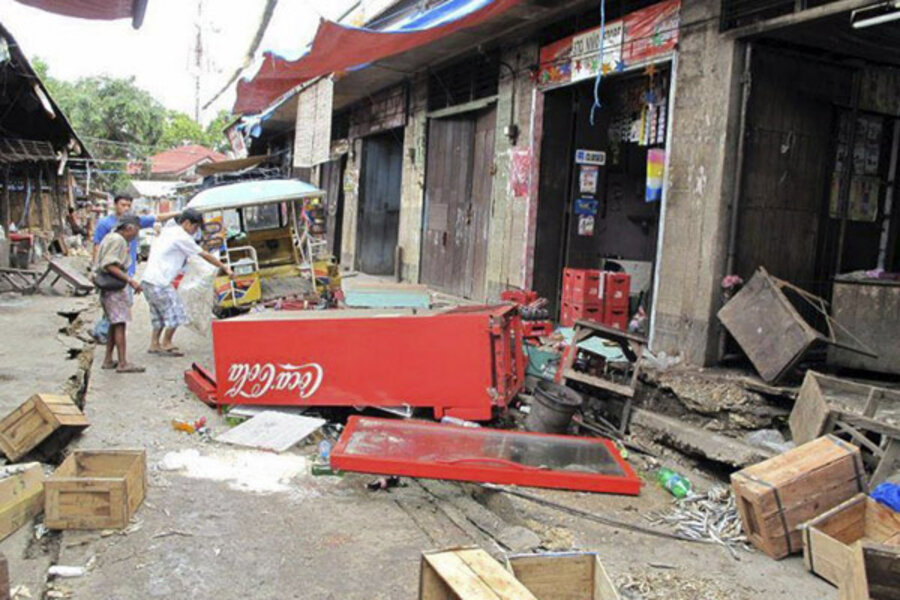Rescuers dig to reach dozens after Philippines quake
Loading...
| MANILA, Philippines
Rescuers dug with picks and shovels trying to reach dozens of people trapped under houses collapsed by a strong earthquake Monday that shook a central Philippine island and set off landslides.
At least 13 people were killed and 40 are believed missing, most of them along the shore near the epicenter of the 6.9-magnitude quake that struck in a narrow strait just off Negros Island.
In the mountain village of Planas, 9 miles (15 kilometers) from coastal Guihulngan town in Negros Oriental province, as many as 30 houses were buried with at least 40 residents believed trapped, said Gov. Roel Degamo.
"Their situation is bad because if you are covered by landslide for one hour, two hours, how can you breathe?" Mayor Ernesto Reyes said. "But we just hope for the best, that there are still survivors."
Army troops and police were deployed to help in the rescue.
At least 10 people were confirmed dead in Guihulngan, including students at a college and an elementary school and others in a town market that collapsed, Reyes said. About 100 were injured.
The quake, which hit at 11:49 a.m. (0349 GMT), triggered another landslide in the mountain village of Solongon in La Libertad town, also in Negros Oriental. An unknown number of people were trapped, said La Libertad police chief inspector Eric Arrol Besario.
"We're now getting shovels and chain saws to start a rescue because there were people trapped inside. Some of them were yelling for help earlier," Besario told The Associated Press by phone. Three key bridges in the town cracked and were no longer passable, he said.
Food and medicines were waiting in the provincial capital of Dumaguete, but the aid could not reach the villages in need because of damaged roads and bridges.
"There is a Canadian and an Indian doctor who are here for an earlier scheduled medical mission and it's good that they are helping us," said Reyes. "They have some medicines with them but that may not be enough."
Nine bridges were damaged in Negros Oriental, including four that were not passable, said Gov. Degamo. The worst damage was concentrated in the province's mountainous northern portion, he said.
Philippine seismologists briefly issued a tsunami alert for the central islands. Huge waves washed out five bamboo and wooden cottages from a beach resort in La Libertad, but there were no reports of injuries, said police Superintendent Ernesto Tagle. Elsewhere along the coast, people rushed out of schools, malls and offices.
Two people died in another town close to the epicenter, Tayasan, including a child when a concrete fence of a house collapsed, said Benito Ramos, head of the Office of Civil Defense.
Another child was killed in a church when a wall collapsed during a funeral in Negros Oriental's Jimalalud town, Mayor Reynaldo Tuanda said.
Tayasan police officer Alfred Vicente Silvosa told AP by phone that aftershocks were preventing people from returning to their homes.
"We are outside, at the town plaza. We cannot inspect buildings yet because it's dangerous," Silvosa said. "I felt the building shaking, so I rushed out of the building. Our computers, shelves, plates, the cupboards, water dispenser all fell."
A three-story office building also collapsed in La Libertad, but occupants escaped.
Negros Oriental police chief Edward Carranza said the temblor damaged many houses in Guihulngan and he ordered his men to help displaced residents find shelter.
Officials in some areas suspended work and canceled classes. Power and telecommunications were knocked out in several places.
Carranza said police rushed out of his building when the quake struck. "All my personnel ran out fearing our building would collapse," he said.
"Now it's shaking again," he said as an aftershock hit. "My keychain is dancing."
The U.S. Geological Survey said the quake was centered 44 miles (72 kilometers) north of Dumaguete city on Negros and hit at a depth of 29 miles (46 kilometers). The area is about 400 miles (650 kilometers) southeast of the capital, Manila.
The Philippines is in the Pacific "Ring of Fire" where earthquakes and volcanic activity are common. A 7.7-magnitude quake killed nearly 2,000 people in Luzon in 1990.
The latest quake was set off by movement in an undersea fault, said Renato Solidum of the Philippine Institute of Volcanology and Seismology. Negros was rocked by an 8.2-magnitude quake in 1948 but it did not cause additional massive damage because the region was still reeling from the devastation of World War II, he said.







